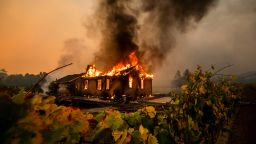The Dixie Fire, the second-largest wildfire in California’s history, was sparked when power lines owned by Pacific Gas and Electric (PG&E) came into contact with a tree, fire officials said.
The Dixie Fire started July 13 and went on to burn 963,309 acres across five counties in Northern California before being contained on October 25, according to Cal Fire.
The wildfire destroyed 1,329 structures, including much of the small community of Greenville, about 170 miles north of Sacramento. Several firefighters were injured while working to contain the massive swath of flames.
Investigators conducted a “meticulous and thorough” investigation and determined the fire was caused by a tree contacting power lines owned and operated by PG&E located west of Cresta Dam in Plumas County, Cal Fire said in a news release Tuesday.
PG&E, in a statement, said the tree was one of more than 8 million within strike distance of its power lines. “Taking a bold step forward, PG&E has committed to burying 10,000 miles of lines in addition to the mitigations included in PG&E’s 2021 Wildfire Mitigation Plan,” the utility said.
“Regardless of today’s finding, we will continue to be tenacious in our efforts to stop fire ignitions from our equipment and to ensure that everyone and everything is always safe,” PG&E said.
The Dixie Fire investigative report was sent to the Butte County District Attorney’s Office, Cal Fire said. CNN reached out to the district attorney’s office for comment.
Utility facing scrutiny over fires
PG&E has faced scrutiny in recent years over its equipment’s role in a spate of deadly and destructive California fires.
In 2020, PG&E pleaded guilty to 85 counts, including involuntary manslaughter and unlawfully starting the Camp Fire, the deadliest fire in the state’s history.
Last month, the utility was fined $125 million for its role in the 2019 Kincade Fire in Sonoma County as part of a settlement with the California Public Utilities Commission.
Cal Fire determined the fire was caused by PG&E’s transmission lines. Dry vegetation, strong winds, and warm temperatures accelerated the flames, which destroyed 374 structures and injured four people, according to Cal Fire.
“We will continue our work to make it safe and make it right, both by resolving claims stemming from past fires and through our work to make our system safer tomorrow than it is today,” PG&E said in a statement about the Kincade settlement.
The statement went on to say the company accepted Cal Fire’s finding that a PG&E transmission line caused the Kincade fire, but “disagree with SED’s (CPUC’s Safety and Enforcement Division) alleged violations.”
“We believe the settlement will assist in allowing all parties to move forward from the fire, and permit us to focus on compensating victims and making our energy system safer,” the statement added.
In April last year, criminal charges were filed against PG&E over the Kincade Fire. The charges consisted of five felonies and 28 misdemeanors including unlawfully starting a fire which caused bodily injury, unlawfully burning inhabited structures, unlawfully causing a fire which burned forests, and various air pollution crimes, according to the Sonoma County District Attorney’s Office.
And in September, criminal charges, including four counts of involuntary manslaughter, were filed against the utility in Shasta County over 2020’s deadly Zogg Fire, prosecutors said.
The fire, which was sparked by a pine tree contacting PG&E electrical lines, burned more than 56,000 acres in September 2020. In addition to claiming four lives, the Zogg Fire injured one, destroyed 204 residential and commercial structures and damaged 27 others.
In both criminal cases, PG&E said it accepted findings that its transmission lines started the fires but denied criminal wrongdoing.
CNN’s Mallika Kallingal, Stella Chan and Madeline Holcombe contributed to this report.







